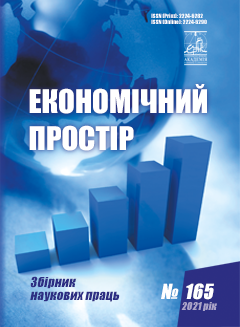CURRENT STATE OF THE VOLUME OF IMPLEMENTED INFORMATION SERVICES IN UKRAINE AND REGIONS
Abstract
In the context of accelerated globalization, the question of rapid adaptation of information services has arisen. Today, the influence of information is widespread in all dominant industries, thanks to them; the development of automation, there is a departure from the solution of manual and typical problems. All that made possible by the influence of information services, personal computers, smartphones, tablets, etc. For companies – this is a good opportunity, in a clear redistribution of labor, work planning and calculation of accurate time management. For the state – information technology, one of the priority links of development. Almost 5% of GDP makes it possible to fully assume that the IT sector is dominant in the economy of Ukraine and its regions. Further development of the industry will have a positive effect on the financial stability of the country, thanks to the inflow of foreign currency, the opening of startups and the creation of information centers for training. The creation and improvement of information technology training institutes has been introduced. Implement programs to open small and medium-sized businesses related to outsourcing. This, in turn, will increase scientific literature, full access to education services, in particular, access to electronic resources of the entire Internet, facilitate the acquisition of knowledge, working and living conditions, creating comfortable jobs, etc. Accordingly, the overall strategy for the development of information technology in Ukraine is the rapid spread and development of competitive ICT technologies for the entire public sphere of Ukraine and its economy, which will increase productivity, development of information structure, such as the Internet segment. On the basis of the research data’s were: economic status and ease of job search; transport infrastructure; lifetime; population mobility, i.e. the percentage of residents who visited foreign resorts; ecology and safety of living. By 2019, the IT sector had brought almost $ 5 billion to the state treasury and has a favorable outlook for larger exports and GDP. Therefore, there was a problem in analyzing the volume of services provided in Ukraine and regions.
References
Валовий регіональний продукт у 2018 році. URL: http://ukrstat.gov.ua/druk/publicat/kat_u/2020/zb/04/zb_vrp_2018.pdf (дата звернення 19.01.21).
Думная Н.Н. Риски финансовой глобализации. Бизнес академия. 2002. №7(17). С. 34–40.
Дятлов С.А. Информационно-сетевая экономика: структура, динамика, регулирование. СПб, 2008. C. 211–213.
Дятлов С.А. Принципы информационного общества. URL: http://emag.iis.ru/arc/infosoc/emag.nsf/BPA/34a0170934d95e29c32569e5004d6643 (дата звернення 12.11.20).
Лідери в рейтингу комфортності українських міст. URL: https://ua-news.liga.net/economics/pr/liderom-v-reytingu-komfortnosti-ukrainskih-mist-v-2020-rotsi-vpershe-stav-hmelnitskiy (дата звернення 12.11.20).
Маслов А.О. Генеза теорії інформаційної економіки та її місце в сучасній економічній думці. Актуальні проблеми економіки. 2011. № 3. С. 13–23.
Робоча сила України 2019. URL: http://www.ukrstat.gov.ua/druk/publicat/kat_u/2020/zb/07/zb_r_s_2019.pdf (дата звернення 19.01.21).
Сайт Державної статистики України. URL: http://www.ukrstat.gov.ua (дата звернення: 12.11.20).
Степаненко С.В. Інтелектуалізація економіки як ознака постіндустріального суспільства. Полтава, 2005. С. 182–186.
Стрелец И.А., Столбов М.И. Роль финансовых инноваций в распостранении экономической нестабильности. Мировая экономика и международные отношения. 2011. № 6. С. 56–54.
Стрелец И.А. Сетевая экономика: ученик. Москва, 2006. 208 с.
Титенко О.А. Інформаційна економіка в Україні: сучасний стан, проблеми та шляхи подальшого розвитку. 2014. С. 180–190. URL: https://ir.kneu.edu.ua/bitstream/handle/2010/12546/180-190.pdf?sequence=1(дата звернення: 15.11.20).
Valovyi rehionalnyi produkt u 2018 rotsi. URL: http://ukrstat.gov.ua/druk/publicat/kat_u/2020/zb/04/zb_vrp_2018.pdf (ac-cessed 19 January 2021).
Dumnaia N.N. (2002). Rysky fynansovoi hlobalyzatsyy. Byznes akademyia, no. 7(17), рр. 34–40.
Diatlov S.A. (2008). Ynformatsyonno-setevaia ekonomyka: struktura, dynamyka, rehulyrovanye. SPb, рр. 211–213.
Diatlov S.A. Pryntsypy ynformatsyonnoho obshchestva. URL: http://emag.iis.ru/arc/infosoc/emag.nsf/BPA/34a0170934d95e-29c32569e5004d6643 (accessed 12 November 2020).
Lidery v reitynhu komfortnosti ukrainskykh mist. URL: https://ua-news.liga.net/economics/pr/liderom-v-reytingu-komfortnos-ti-ukrainskih-mist-v-2020-rotsi-vpershe-stav-hmelnitskiy (accessed 12 November 2020).
Maslov A.O. (2011). Heneza teorii informatsiinoi ekonomiky ta yii mistse v suchasnii ekonomichnii dumtsi. Aktualni problemy ekonomiky, no. 3, рр. 13–23.
Robocha syla Ukrainy 2019. URL: http://www.ukrstat.gov.ua/druk/publicat/kat_u/2020/zb/07/zb_r_s_2019.pdf (accessed 19 January 2021).
Sait Derzhavnoi statystyky Ukrainy. URL: http://www.ukrstat.gov.ua (accessed 12 November 2020).
Stepanenko S.V. (2005). Intelektualizatsiia ekonomiky yak oznaka postindustrialnoho suspilstva. Poltava, рр. 182–186.
Strelets Y.A., Stolbov M.Y. (2011). Rol fynansovykh ynnovatsyi v raspostranenyy ekonomycheskoi nestabylnosty. Myrovaia ekonomyka y mezhdunarodnye otnoshenyia, no. 6, рр. 56–54.
Strelets Y.A. (2006). Setevaia ekonomyka: uchebnyk. Moskva, 208 р.
Tytenko O.A. (2014). Informatsiina ekonomika v Ukraini: suchasnyi stan, problemy ta shliakhy podalshoho rozvytku, рр. 180–190. URL: https://ir.kneu.edu.ua/bitstream/handle/2010/12546/180-190.pdf?sequence=1 (accessed 15 November 2020).



